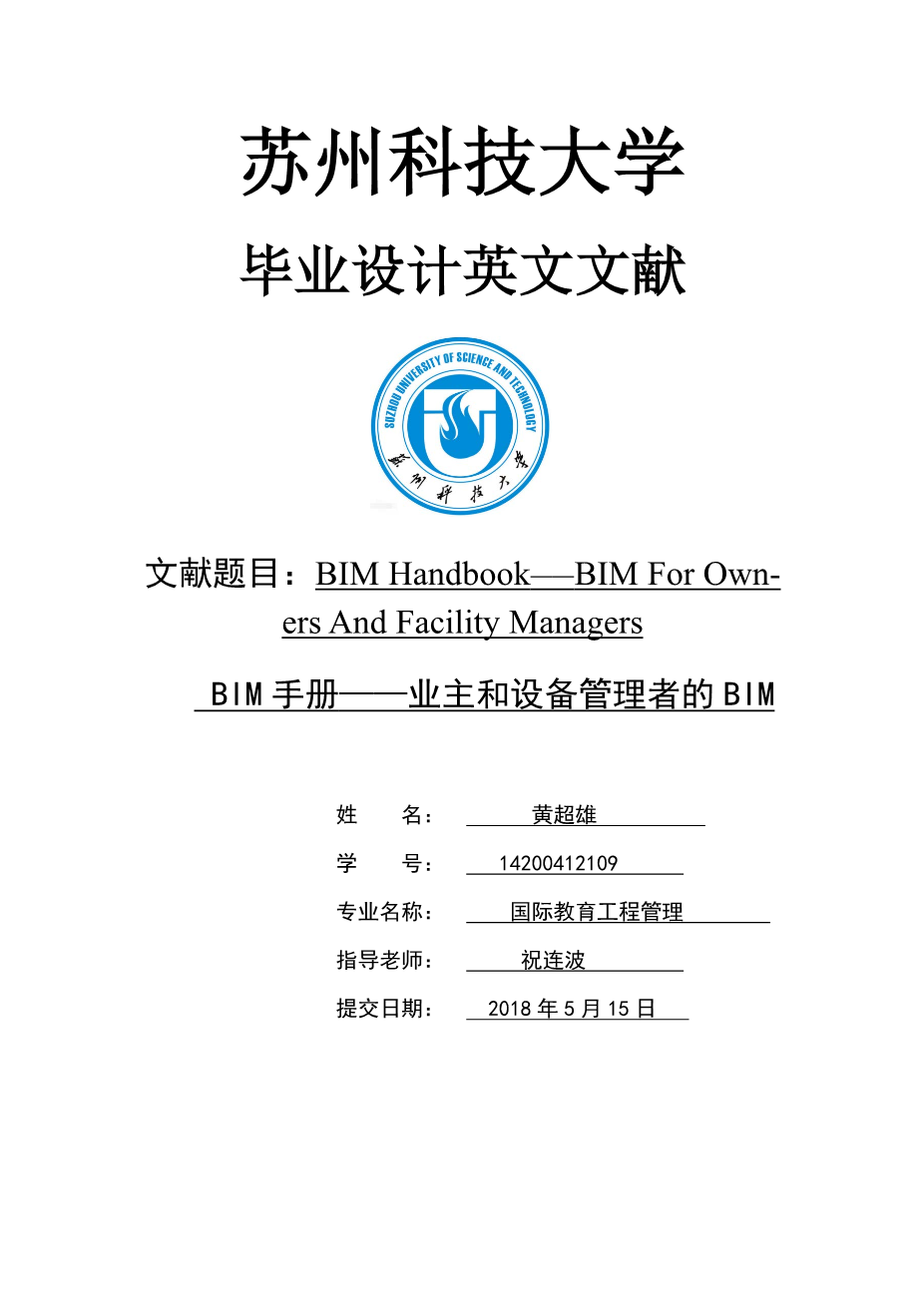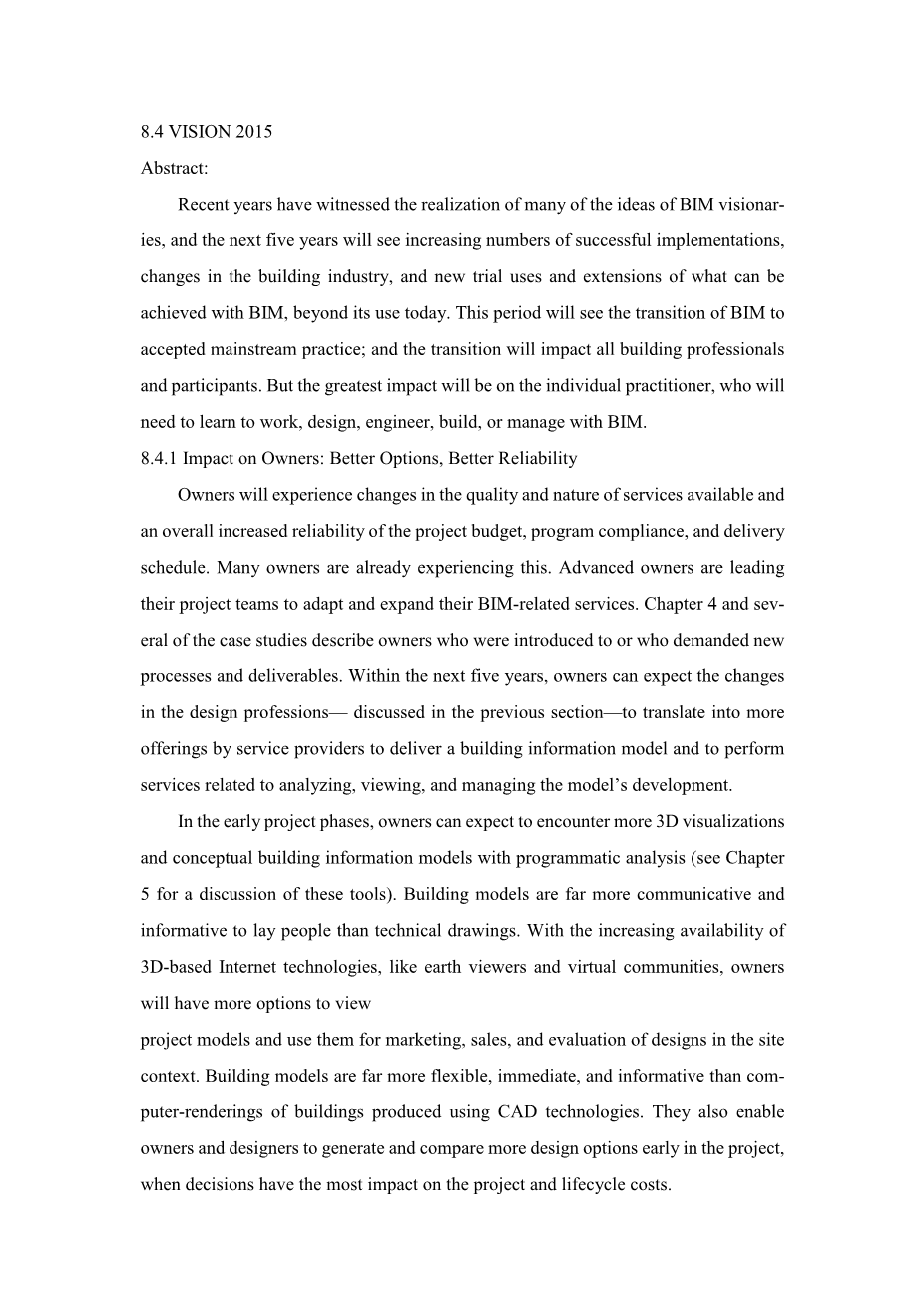8.4 VISION 2015
Abstract:
Recent years have witnessed the realization of many of the ideas of BIM visionaries, and the next five years will see increasing numbers of successful implementations, changes in the building industry, and new trial uses and extensionsof what can be achieved with BIM, beyond its use today. This period will seethe transition of BIM to accepted mainstream practice; and the transition willimpact all building professionals and participants. But the greatest impact will be on the individual practitioner, who will need to learn to work, design, engineer, build, ormanage with BIM.
8.4.1 Impact on Owners: Better Options, Better Reliability
Owners will experience changes in the quality and nature of services availableand an overall increased reliability of the project budget, program compliance,and delivery schedule. Many owners are already experiencing this. Advancedowners are leading their project teams to adapt and expand their BIM-relatedservices. Chapter 4 and several of the case studies describe owners who wereintroduced to or who demanded new processes and deliverables. Within thenext five years, owners can expect the changes in the design professions—discussed in the previous section—to translate into more offerings byserviceproviders to deliver a buildinginformation model and to perform servicesrelated to analyzing, viewing, and managing the model’s development.
In the early project phases, owners can expect to encounter more 3Dvisualizations and conceptual building information models with programmaticanalysis (see Chapter 5 for adiscussion of these tools). Building models arefar more communicative and informative to lay people than technical drawings.With the increasing availability of 3D-based Internet technologies, likeearth viewers and virtual communities, owners will have more options to view
project models and use them for marketing, sales, and evaluation of designs inthe site context. Building models are far more flexible, immediate, and informativethan computer-renderings of buildings produced using CAD technologies.They also enable owners and designers to generate and compare more designoptions early in the project, when decisions have the most impact on theproject and lifecycle costs.
These technical developments will have different impacts for differentowners, depending on their business incentives. Owners who build to sellwill find that they can demand and achieve much shorter design durations forconceptual design and construction documentation. On the other hand,for owners who have an economic interest in the lifecycle costs and energy
efficiency of their buildings, the conceptual design stage will provide theopportunity for an in-depth study of the behavior of each alternative buildingdesign. Savvy owners—with the perception that conceptual-level modelscan be developed and evaluated rapidly—are likely to demand higher designquality. In an effort to optimize building design, they will demand thoroughexploration of more alternatives, in terms of construction cost, sustainability,energy consumption, lighting, acoustics, maintenance, and operations andother criteria.
During this time period, more advanced analysis and simulation tools willemerge as options for specific types of facilities, such as healthcare, publicaccess areas, stadiums, transit facilities, civic centers, and educational centers.Figure 8–3 shows an example of a tool that allows owners and theirdesigners to compare different configurations of hospital rooms with different
equipment. Since the actual occupants and
users are central to assessing andevaluating anydesign, tools that work integrally with a BIM system to provideintelligent configurationcapabilities will become more widespread.
Similarly, sophisticated construction clients will drive the developmentof automated design review software for different building types. These willassess a given building design at different stages of development and accordingto different preset guidelines. For example, the GSA is already extendingits program area checking tool to other aspects of design and otherbuildingtypes. One program allows for circulation assessments of various layoutoptions during conceptual design. It focuses on courthouses, which havemajor circulation and securityrequirements. An early example of this type oftesting is shown in Figure 8–4. Other public or private organizations can beexpected to develop similar protocols for other building types, such as hospitalsand schools.
For first-time (and often one-time) construction clients, different andless desirablepossibilities may occur. They may not be familiar with BIMand its potential uses and, as a result, may not adequately engage the designteam in assessing the project’smoresubtle goalsregarding function, cost,and time-to-delivery. If designers are not disciplined, they can develop fairlydetailed designs rapidly and create building models that appear convincingand appealing. If the vital stage of conceptual design is short-circuited, prematureproduction level modeling can lead to a lot of rework later in theprocess. In the worst cases, inadequately designed buildings that do not meetthe clients’ needs may be built. Like any powerful technology, BIM too isopen to abuse. Building clients unfamiliar with the capabilities that BIMtechnology offers are advised to educate themselves and select knowledgeabledesign consultants in order to obtain professional design services thatexploit the technological capabilities of BIM to achieve the desired objectives
of the project.
Smart owners, on the other hand, will demand a faster and more reliablebuilding process from their design and construction teams. The use of design-bid-build for private construction will continue to decline, as owners realize that an integrated team is the best way to obtain value from BIM technology.
They will sta
剩余内容已隐藏,支付完成后下载完整资料


英语译文共 7 页,剩余内容已隐藏,支付完成后下载完整资料
资料编号:[469140],资料为PDF文档或Word文档,PDF文档可免费转换为Word
以上是毕业论文外文翻译,课题毕业论文、任务书、文献综述、开题报告、程序设计、图纸设计等资料可联系客服协助查找。


